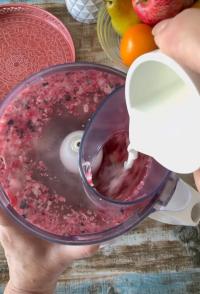Copy Link
Add to Bookmark
Report
Mead Lovers Digest #0004

Subject: Mead Lover's Digest #4 (September 30, 1992)
Date: Wed, 30 Sep 92 01:00:03 -0700
From: mead-lovers-request@nsa.hp.com (Mead Digest)
Mead Lover's Digest #4 Wed 30 September 1992
Forum for Discussion of Mead Brewing and Consuming
John Dilley, Digest Coordinator
Contents:
hi-gravity mead (Aaron Birenboim)
mead-related stuff (Roy Rudebusch)
Some Weird Experiences (Daniel R. Pomplun)
aging (jimf)
Send articles for submission to the digest to mead-lovers@nsa.hp.com
Send digest addition or removal requests to mead-lovers-request@nsa.hp.com
----------------------------------------------------------------------
Date: Tue, 29 Sep 92 07:54:55 MDT
From: abirenbo@rigel.cel.scg.hac.com (Aaron Birenboim)
Subject: hi-gravity mead
Rich Hargan asked about his 1.135 O.G. mead.
I have done one strong mead like this. i do not remember the O.G.
but it was a bit over 25% potential alchahol, with champagne yeast.
This stuff is sweet and syrupy, but pretty good. Better than the
scottish mead i once had which i was trying to emulate. Mine tasted
smooth as a baby's buttocks and very honey-like. theirs tasted like
cough syrup.
Most champagne yeasts conk out around 17-19% alchahol. I am currently
running an eldeberry mead at 19.5% pot alchahol. Fermemtation has
slowed to a trickle at s.g. 1.030. So... I'm still searching
for the magical O.G. for my yeast. From the recent zymurgy article,
i see that every yeast will have different "sweetness" perception
indepenmdant of O.G. and T.G. I plan to stick with lalvin ec-1118
for the strong stuff, and see what fits my tastes. I have found
that the only meads i really liked are strong and sweet. weaker
meads do not have enough honey character for me. However, i do plan
to experiment with WYEAST european ale (like 66% attenuation) for`
a weaker product.... as soon as i get this year's honey in.
I'd say that 12#/gal is about right... and 3 to 3.5# honey/gallon
of mead is a rule of thumb for honey concentration. However, I find
it easier to take a mess o hydrometer readings and just pour from the
honey bucket til i get my desired o.g.
Also... my extra sweet mead is really to sweet to drink straight.
I "blend" it at the table with my dry meads for a truely excellent
drink. Just be sure to refer to this process as "blending" as in
the fine french wine tradition.... not mixing 2 mediocre meads to
get one good one.`
aaron
------------------------------
Date: Tue, 29 Sep 92 09:31:00 -0500
From: roy.rudebusch@travel.com (Roy Rudebusch)
Subject: mead-related stuff
From: roy.rudebusch@travel.com
Dear Fellow Traditional Beverage (mead) Fans;
I liked what Ted Manahan said about using an ale yeast to ferment with.
Steve Lamont wanted to quick mead recipe:
(BTW 1 gal of honey should weigh 12#)
First brew an ale with a clean culture of W-yeast.
Rec. W-1007, W-1056, (highly rec. W-1028).
Boil .5 oz saaz hops in 2 qts water then:
Dilute 6# of honey to 4 gallons water and add:
hop water, top up to 5 gal. add:
.5 tsp SO2
1 tsp pectic enzyme
no yeast nutrient neccesary!
Let this solution rest for three days.
After three days bottle the ale-beer, SAVE THE SEDIMENT!
Pour the above solution onto the sediment, add .5 oz saaz hops, (no
need to sterilize the hops), pour the must back and forth several times,
being sure all the yeast is dislodged from the original fermenter.
The ale yeast that fermented the beer is full of nutrients (fat
and happy), this mead should ferment out in less than 2 days.
Bottle the mead as you would a beer.
In order to have a successful mead-ferment the original ale-beer should
first have been a healthy, quick ferment.
Bob Emery wrote that his mead was too dry. Join the club! This problem
is the common complaint of mead-makers.
To produce a sweeter mead use the above ale yeast technique. Use
about 15# honey and hope the yeast conks out at about 1.015.
Also Bob asked, "any good meadmaking books", NO! Save your money. I
called up one of the authors once to ask him a question about adding
herbs and spices to mead, and he said he has never made mead before and
has never heard of anybody using those ingedients in mead!
All the books contain so many old-fashioned wine-making techniques that
it makes the recipes and techniques nearly worthless.
Forgive me if I sound callous. These books were fine 10 years ago, but
mead and wine-making has progressed and it is up to us to promote good
technique.
For basic mead-making info. see TNCJoHB by Charle Papazion.
Wassail!
* OLX 2.2 * A Family that Brews MEAD Together Stays Together
------------------------------
Date: Tue, 29 Sep 92 12:15:52 -0400
From: Daniel R. Pomplun <danp@nemesis.bsi.bellcore.com>
Subject: Some Weird Experiences
First, I'd like to thank John for setting up the mailing list.
I lean slightly towards a digest format, but realize that it takes
effort to maintain, and would be happy with either format.
My background: I started making mead about a year ago, and to date have
started 12 1-gallon experimental batches and 2 5-gallon batches. I've
tried both boiling and sulfiting the honey (I prefer sulfiting), and like
to experiment with fruit (kiwi, apple, strawberry, and blueberry so far)
and ginger.
Now, to business. In order to determine how long it takes ferment out
a batch, I've been recording the fermentation rate of each of my batches
using the (infamous) measurement "bubbles per second through the
fermentation lock".
Charting this, most batches look like:
x
x x
x xx
x xxx
x xxxxxx
x xxxxxxxx
x xxxxxxxxxx
rapid growth, followed by "exponential" decay.
However, a couple of batches looked like:
x
x x x
x x x xxx
x xx xxxxxx
x xxxxxxxx
x xxxxxxxxxx
After initial rapid growth, the fermentation rate limped along, eventually
regrew, and then showed "exponential" decay.
Does anyone have any ideas why this is happening? Has anyone seen this
before?
The yeast seemed active the whole time. In most batches, I've noticed
that during the rapid growth stage, the yeast is multiplying and is working
it's way through the solution from top to bottom. When the yeast first
hits bottom is about when it reaches its fermentation rate peak.
Perhaps there is something in the initial sediment (I use irish moss) which
makes contact with the downward working yeast, and somehow retarts its growth.
Could there be leftover sulfite in the sediment?
Daniel Pomplun, Bellcore, danp@sabre.bellcore.com
Phone: (908) 758-2740 Fax: (908) 758-4268
331 Newman Springs Rd, Red Bank, NJ 07701-7020, MS: NVC-1E246
"The answers to life's problems aren't at the bottom of a bottle:
they're on TV!"
-- Homer Simpson
------------------------------
Date: Tue, 29 Sep 92 15:35 CDT
From: jimf@iwtdr.att.com
Subject: aging
Is there any mead recipe/method which does not require a long aging
period (e.g. more like cider)?
------------------------------
End of Mead Lover's Digest
************************



























